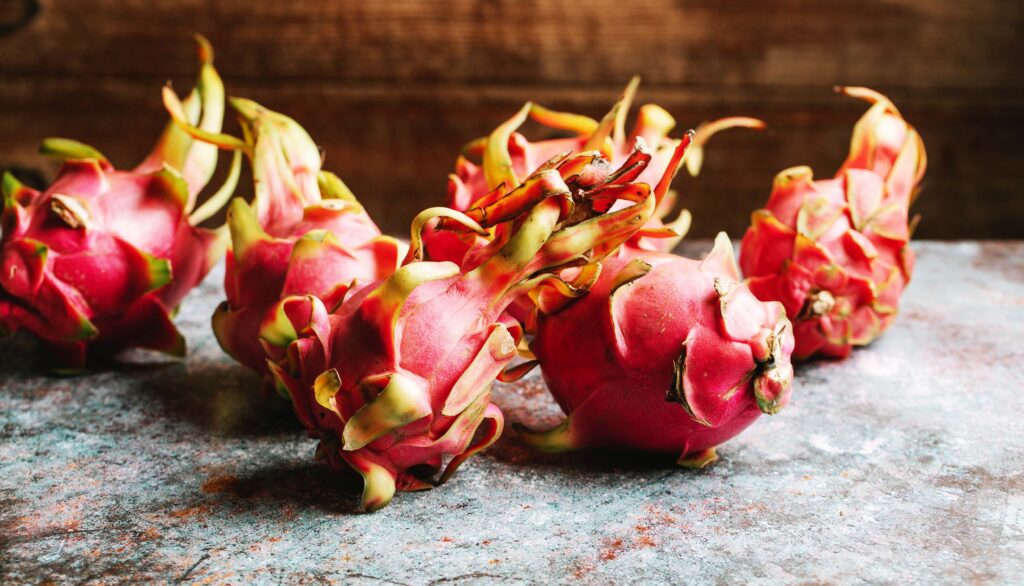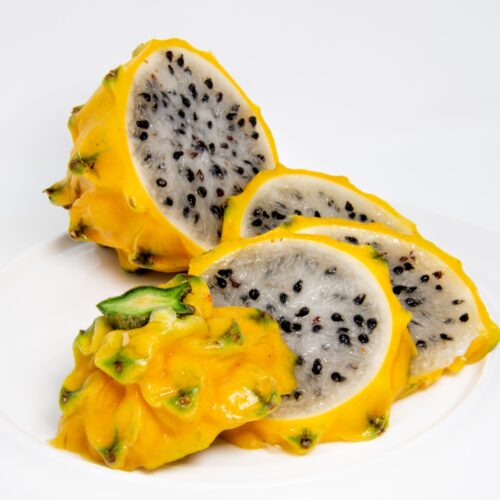
Uncover the Exotic Roots of Dragon Fruit: From the Ancient Americas to Modern-Day Asia
Dragon fruit, also known as pitaya, is a tropical fruit that has gained popularity in recent years due to its unique appearance and potential health benefits. This fruit, which comes in several varieties and colors, is not only low in calories but also a rich source of fiber, vitamin C, antioxidants, and iron.
The taste of this fruit is often described as mild and sweet, with a texture similar to that of kiwi fruit. Some people compare its flavor to a cross between a pear and a kiwi, while others say it tastes similar to watermelon or a mix of tropical fruits.
Flavors can vary slightly depending on the variety of this fruit, with some types being sweeter or more tart than others, but Dragon fruit has a refreshing and somewhat exotic taste.
From promoting digestive health to potentially reducing the risk of heart disease, this colorful fruit offers several potential health benefits that make it a nutritious addition to any diet.
 Here are some great things about dragon fruit and its health benefits:
Here are some great things about dragon fruit and its health benefits:
- Low in calories: Dragon fruit is low in calories, making it a good option for those trying to maintain or lose weight.
- Rich in fiber: It is a good source of fiber which can help regulate digestion, prevent constipation, and promote satiety.
- High in vitamin C: This fruit is an excellent source of vitamin C, which is essential for immune function, skin health, and wound healing.
- Antioxidant-rich: It is also rich in antioxidants, including betalains, which may help protect against cellular damage and chronic disease.
- Good for heart health: Dragon fruit may help lower cholesterol levels and reduce the risk of heart disease due to its high fiber and antioxidant content.
- Potential anti-inflammatory properties: Some research suggests that the antioxidants may have anti-inflammatory properties, which could benefit conditions such as arthritis and inflammatory bowel disease.
- Rich in iron: It also contains iron, an essential mineral that is important for oxygen transport and energy production.
 Can you cook with dragon fruit?
Can you cook with dragon fruit?
While this fruit is often eaten raw, it can also be used in various recipes.
Here are some ways you can cook with it:
- Smoothies and juices: It can be blended into smoothies and juices for a refreshing and nutritious drink.
- Salads: Slice it and add into salads for a sweet and crunchy texture.
- Salsa: Dice it and combine with other ingredients to make a flavorful salsa.
- Grilled: Grill it for a few minutes on each side for a caramelized flavor.
- Desserts: Create delicious desserts such as sorbet, ice cream, and pudding.
Tip: It is important to note that when cooking with dragon fruit, its vibrant color may fade or change, so keep that in mind when incorporating it into your dishes.
Did you know?
Dragon fruit is not native to Asia, where it is most commonly grown and consumed. It is believed to have originated in Central and South America and was then brought to Asia by European colonizers in the 19th century.
Today, dragon fruit is cultivated in several countries worldwide, including Vietnam, Thailand, and Malaysia, as well as in some parts of the United States, such as California and Florida.
A little history:
Also known as pitaya, this beautiful fruit has a history that spans several centuries and continents. While its exact origin is unknown, this fruit is believed to have originated in Central and South America, where it has been cultivated for thousands of years. It is believed that the indigenous peoples of these regions were the first to discover and consume it, becoming a food source and a medicine to treat various ailments.
Dragon fruit was then introduced to Asia by European colonizers in the 19th century. The fruit was brought to Vietnam, where it quickly gained popularity due to its unique appearance and potential health benefits.

The fruit was then introduced to other countries in Southeast Asia, including Thailand, Malaysia, and the Philippines, where it became a popular fruit crop.
Today, the fruit is cultivated in many countries worldwide, including the United States, Australia, Israel, and several European countries. Its popularity has grown in recent years, partly thanks to its unique appearance and potential health benefits.
Its history is a testament to how foods and cultures can cross continents and evolve while retaining their unique characteristics and health benefits.


